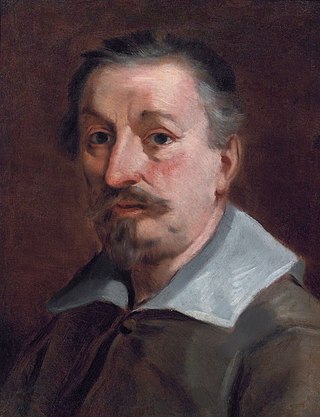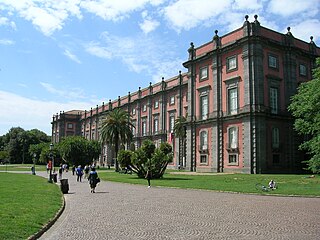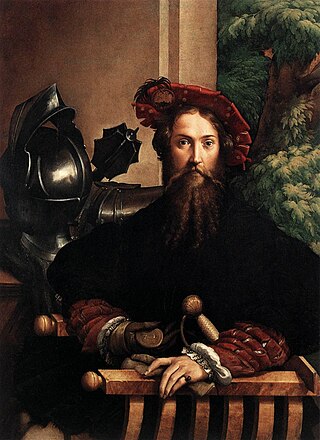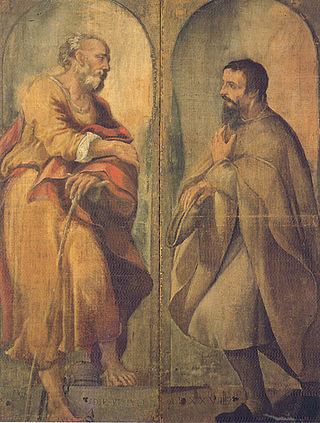
Saint Jerome or Penitent Saint Jerome is a c.1640-1650 oil on canvas painting by Guercino, now in the Royal Palace of Naples. [1]

Saint Jerome or Penitent Saint Jerome is a c.1640-1650 oil on canvas painting by Guercino, now in the Royal Palace of Naples. [1]
Its origins are unknown - 20th century art critics argue it was commissioned by someone featured in the painter's accounts book. [1] The work dates to 1640–1650, a period when figures from Cento, Ferrara and Bologna were commissioning works from him for sums between around 50 and 67 scudi. [1]
The earliest definite reference to the work dates to 1680, when it was recorded at the Palazzo del Giardino in Parma as part of the Farnese collection, though it is unknown how it entered that collection. In 1734, before being moved to Naples, the Jerome was recorded as being at the Ducal Palace in Parma. [1] When Elisabeth Farnese's son Charles of Bourbon came to the throne of the Two Sicilies, it and the rest of the Farnese collection was moved to Naples. [1] The work was then largely forgotten before being re-evaluated at the end of the 20th century.

Agostino Carracci was an Italian painter, printmaker, tapestry designer, and art teacher. He was, together with his brother, Annibale Carracci, and cousin, Ludovico Carracci, one of the founders of the Accademia degli Incamminati in Bologna. This teaching academy promoted the Carracci emphasized drawing from life. It promoted progressive tendencies in art and was a reaction to the Mannerist distortion of anatomy and space. The academy helped propel painters of the School of Bologna to prominence.

Jusepe de Ribera was a painter and printmaker, who along with Francisco de Zurbarán, Bartolomé Esteban Murillo, and the singular Diego Velázquez, are regarded as the major artists of Spanish Baroque painting. Referring to a series of Ribera exhibitions held in the late 20th century, Philippe de Montebello wrote "If Ribera's status as the undisputed protagonist of Neapolitan painting had ever been in doubt, it was not longer. Indeed, to many it seemed that Ribera emerged from these exhibitions as not simply the greatest Neapolitan artist of his age but one of the outstanding European masters of the seventeenth century." Jusepe de Ribera has also been referred to as José de Ribera, Josep de Ribera, and Lo Spagnoletto by his contemporaries, early historians, and biographers.

Francesco Albani or Albano was an Italian Baroque painter who was active in Bologna (1591–1600), Rome (1600–1609), Bologna (1609), Viterbo (1609–1610), Bologna (1610), Rome (1610–1617), Bologna (1618–1660), Mantova (1621–1622), Roma (1623–1625) and Florence (1633).

Odoardo Farnese was an Italian nobleman, the second son of Alessandro Farnese, Duke of Parma and Maria of Portugal, known for his patronage of the arts. He became a Cardinal of the Roman Catholic Church in 1591, and briefly acted as regent of the Duchy of Parma and Piacenza for his nephew Odoardo from 1622 to 1626.

Giovanni Lanfranco was an Italian painter of the Baroque period.

Museo di Capodimonte is an art museum located in the Palace of Capodimonte, a grand Bourbon palazzo in Naples, Italy. The museum is the prime repository of Neapolitan painting and decorative art, with several important works from other Italian schools of painting, and some important ancient Roman sculptures. It is one of the largest museums in Italy. The museum was inaugurated in 1957.

Bartolomeo Schedoni was an Italian early Baroque painter from Modena.

Sebastiano Ricci was an Italian painter of the late Baroque school of Venice. About the same age as Piazzetta, and an elder contemporary of Tiepolo, he represents a late version of the vigorous and luminous Cortonesque style of grand manner fresco painting.

The Royal Palace of Capodimonte is a large palazzo in Naples, Italy. It was formerly the summer residence and hunting lodge of the Bourbon kings of the Two Sicilies, one of the two royal palaces in Naples. Today, it comprises the National Museum of Capodimonte and the Royal Forest. The palace was constructed on its somewhat cooler hilltop location just outside the city, with urban Naples ultimately expanding around it.

Portrait of Galeazzo Sanvitale (1524) is a painting of the condottiero Gian Galeazzo Sanvitale by the Italian late Renaissance artist Parmigianino. It is housed in the National Museum of Capodimonte, Naples, Italy.

The Galleria nazionale di Parma is an art gallery in Parma, northern Italy.

Healing of the Man Born Blind is a c.1573 painting by El Greco, showing the healing the man blind from birth. It is now in the Galleria nazionale di Parma. It is signed at the bottom right-hand corner. It shows the artist returning to a theme he had first painted five years earlier, in a work now in Dresden.

Saint Joseph and a Devotee is a 1529 tempera on canvas painting on two panels by Correggio, an attribution first proven in the modern era by Ferdinando Bologna in 1957. The panels are mentioned in the 1680 inventories of the Palazzo del Giardino in Parma as a work by Correggio. It is also recorded as such in Giacomo Barri's Viaggio pittoresco, published in 1671. Until the end of the 18th century it featured in Farnese inventories as a work by Corregio. It was probably moved to Naples with the rest of the Farnese collection in 1734 and is now in the National Museum of Capodimonte there.

Pietà is a c. 1600 oil on canvas painting by Annibale Carracci, the earliest surviving work by him on the subject, which was commissioned by Odoardo Farnese. It moved from Rome to Parma to Naples as part of the Farnese collection and is now in the National Museum of Capodimonte in Naples. It is one of many 16th century Bolognese paintings dedicated to the theme of the Pietà, and it is counted among Carracci's masterpieces.

Madonna and Child with St Peter Martyr and a Donor is a 1503 oil-on-panel painting by Lorenzo Lotto, the first known work by the artist, painted early in his time in Treviso. The two figures to the left are Peter Martyr and a donor or the infant John the Baptist. Its date is inscribed on the reverse as "1503 adì 20 septembris" and – although it is not in Lotto's handwriting as seen in documents – it is a 16th-century hand and therefore accepted.

Penitent Magdalene is a c. 1550 oil on canvas painting by Titian, now in the Museo di Capodimonte in Naples.

Portrait of Cardinal Alessandro Farnese is a c. 1545 – 46 oil on canvas three-quarter-length portrait of Alessandro Farnese the Younger (1520-1589) by Titian, now in the Museo nazionale di Capodimonte in Naples.

Portrait of Pope Paul III with Camauro is a 1545 – 1546 oil on canvas painting by Titian, now in the Museo nazionale di Capodimonte in Naples.

Portrait of Charles V or Portrait of a Man Wearing the Order of the Golden Fleece is a c. 1533-1535 oil on canvas painting by Titian, now in the Museo di Capodimonte in Naples.

Saint Joseph's Dream is a 1600-1650 oil on canvas painting by Guercino, now in the Royal Palace of Naples.